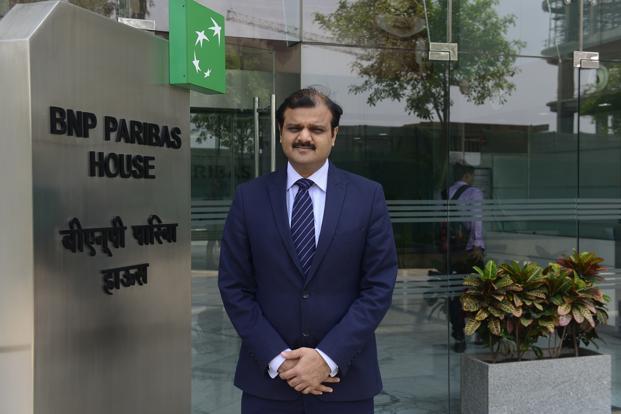
BNP Paribas Asset Management India Pvt. Ltd’s track record, post Anand Shah’s joining the fund house in 2011 has been good. But, the calendar year of 2016 exposed chinks in stock picking strategy. Shah, as the fund house’s chief investment officer (now he is also the deputy chief executive officer and oversees the fund management as well as sales), has always liked investing in shares of consumer-facing companies. But last year, demonetisation and the entry of Reliance Jio in the telecom space adversely impacted his portfolios. His holdings in the telecom sector proved very costly. Will he be able to recover from this fall? Mint spoke to Shah to find out his future strategy. Edited excerpts:
Earlier this year, you had said that demonetisation had impacted your fund house’s equity schemes’ portfolios. It has been around four months since demonetisation. What’s your further assessment?
Re-monetisation appears to be now happening. Money is coming in. The economy that was largely cash-led has suffered, but things there as well are slowly resuming back to normal. So, four-wheelers never really got impacted. But two-wheelers, which largely dealt in cash, were impacted. Multiplexes, which largely dealt with credit cards and online bookings didn’t suffer as much, but single screen theatres where people book tickets largely by cash, suffered. Formal economies didn’t get impacted. The informal economy got adversely impacted.
But things are getting back to normal now. Most of our equity schemes have recovered their losses more or less.
You have always liked businesses that face the consumer. After the demonetisation impact, no matter how temporary an impact it has appeared to have had on the various industries, have you changed your likings about the sort of sectors you invest in?
The B2C businesses has created wealth for investors for decades. They also have more entry barriers and so it is not easy to take away a retail consumer in a hurry. There are valid reasons to invest in B2C companies. Further, the other two segments (business to business or B2B and business to government or B2G) have made a comeback.
In the B2B space, the metals sector is back as the Chinese economy has normalized and there’s hope of an economic recovery in the US. We have exposure to this segment.
In the B2G segment, the government’s spending is up. There are businesses that will benefit from government spending.
A bulk of our portfolios will remain in B2C businesses because comfortable demographics will ensure that it will remain one of the fastest growing segments in the market. On top of it, before demonetisation, we were looking at these companies to do well on the back of a good monsoon last year as well as the pay commission. Both these factors are not going away in a hurry. So, to us, this (demonetisation) is temporary, the B2C segment will only bounce back with a vengeance.
Your schemes’ performance went down big time in the calendar year 2016. Was their exposure to telecom sector the only reason or were there other reasons?
Two things happened together. The good part of the portfolio, business to consumer (B2C) segment companies, which gave me 600-700 bps outperformance for the last 8 years was dealt a blow (demonetisation), which is a once in a century phenomenon. One basis point is one-hundreth of a percentage point. I believe we won’t see another demonetisation for next one century at least. So while the fall in share prices of our holdings in the telecom sector stocks could have been absorbed by the otherwise resilient B2C companies, even the latter got impacted by demonetisation.
When you were buying more shares of Bharti Airtel Ltd throughout 2015-16, did you not see Reliance Jio’s impending impact? There was a lot of buzz around—and expectation from—the telecom company. Something big was expected by most of us.
We were prepared for a 50% lower pricing in data. We were not prepared for free handouts. Nobody anticipated. We have seen in the past that competition exists where the likes of Telenor and Tata Telecom enter the markets offering 30-50% discounts in tariffs and plans. And slowly and gradually, new entrants capture market share. That’s how B2C companies work. They capture market share, but they don’t capture it overnight.
For example, despite some banks like Kotak Bank and Yes Bank offering (close to) 6% interest on savings bank rate, we don’t see people leaving their banks and queuing up outside these banks. The B2B segment is price sensitive; price doesn’t generally matter in the B2C segment.
But Reliance Jio’s strategy and entry was extremely disruptive. It destroyed the sector’s health.
What is your outlook on the telecom sector now and where do you go from here as far your schemes’ exposure to this sector is concerned?
We have already sold our holdings in Idea Cellular much earlier than when Jio came, as that’s where we suffered large underperformance. Bharti Airtel has not performed badly for us, actually.
The telecom sector now is in a complete flux where balance sheets have grown because companies now have to deliver a 4G network in 2017 and 2018, as opposed to 2020. They had to prepone their capital expenditure, be it spectrum purchase or electronic capex. Typically, there is a 10-year cycle for every technology cycle. So, if 3G came in 2010, 4G was expected in around 2020. So now telecom companies have expanded their balance sheets, but their revenues have shrunk due to stiff competition. This combination reduces Return on Capital Employed and Return on Equity, as an industry, to abysmally low levels.
Consolidation has just begun, which is good. We still have more firms than many developed nations. Abroad, there are 2-3 firms, so we will see another year of pain, before another round of consolidation happens.
Analysts have pushed back earnings visibility further. What do you think?
We do have earnings problem at Nifty level but that’s not true for quite a few companies. Despite pockets of volatility in the past 3-4 years, we haven’t had problems of earnings growth for the companies in our portfolios.
If you look at financial year (FY) 2015, the first half (up to September 2014) was profitable, we didn’t have growth issues. We had a de-growth on year-on-year earnings between September 2014 and March 2015. Most of the de-growth came from commodity producers. Earnings didn’t collapse for everybody in the second half of FY2015. And thus, if you look at entire FY15, half of the Nifty companies’ earnings grew at 15% average, and half of Nifty companies’ earnings fell by 15%. And the same story continued in first half of FY16 because year-on-year, the commodity prices were lower. While lower commodity prices were great for macro economy, it had some negative impact on the earnings of the commodity producers.
In the second half of FY16, the Reserve Bank of India (RBI) announced asset quality review of banks’ lending portfolios. Since companies had to recognize their bad assets more stringently, their earnings, led by those of the corporate banks, fell. Those banks that had lent to metal companies suffered further as commodity prices had fallen. And in the second half of 2016, crude oil prices fell from 50$ a barrel to 30$ a barrel and steel prices further went down. So commodity producers and corporate banks dragged down Nifty earning growth in FY16. The country as a whole wasn’t messed up. Some pockets suffered. We had decent growth in earnings for our underlying companies in FY2015 and FY2016.
FY2017 was looking fine with good monsoons (after 2 years) and spending boost due to implementation of pay commission for government employees. But then, in the second half came demonetization, and that has put new doubts on earnings visibility on most of the companies.
Coming back to present times, and looking at expectations for FY2018, we believe that our economy is doing well. Growth is coming back. To a lesser extent than we would like, but I think the government and RBI are doing the right things. Lower interest rates, lower inflation, investments on infrastructure—everything is moving in the right direction. It’s the harder way of economy recovery; wherein we are spending money on roads, railways which doesn’t give us GDP growth rate immediately.
But, I believe these are the right things to do for sustainable economic growth as well sustainable earnings recovery. We believe more than half of the index companies are already benefiting from these activities and it’s not that all the segments of the market are doing badly. There are plenty of opportunities to do stock picking.
Last year apart, your overall long term performance has been good. Yet, BNP Paribas Asset Management India Ltd’s overall assets under management hasn’t grown as much, as opposed to the industry.
Till December 2015, BNP Paribas Asset Management India Ltd was one of the fastest growing asset management companies in the Indian mutual funds industry. Our distribution strength lies in global markets. So globally, we are one of the seven largest offshore funds in the world that invest in India. Our Indian arm is profitable making it one of the very few fund houses in our size bracket to be profitable.
We have to now stabilize our performance, which is happening already. We have strengthened our tie-ups with distributors and last but not the least, we are putting in place our fixed income pie. We are making investments wherever needed.
[Source:-Livemint]




